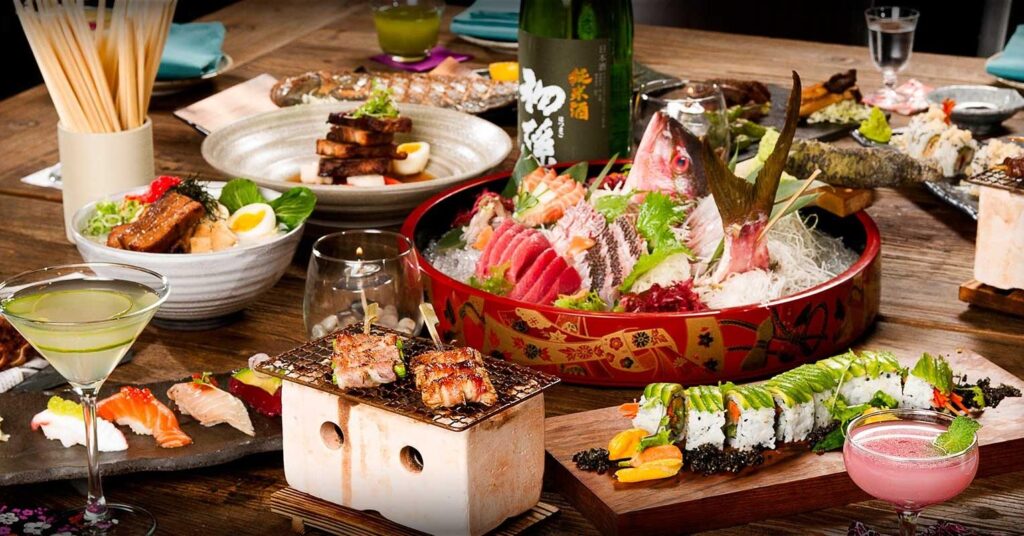Are you curious to know what is robatayaki? You have come to the right place as I am going to tell you everything about robatayaki in a very simple explanation. Without further discussion let’s begin to know what is robatayaki?
Robatayaki, often shortened to just “Robata,” is a traditional Japanese grilling technique and style of dining that has been captivating food enthusiasts worldwide. It’s more than just a method of cooking; it’s a culinary art form that embodies Japan’s reverence for fresh ingredients, meticulous preparation, and the concept of communal dining. In this blog, we’ll explore the world of Robatayaki, from its origins to its unique cooking process and its significance in Japanese culture and beyond.
What Is Robatayaki?
The roots of Robatayaki can be traced back to the fishing villages of Hokkaido, Japan, where fishermen would gather around open fires to grill their catch of the day. The name “Robatayaki” itself is derived from two Japanese words: “Robata,” meaning fireside, and “yaki,” meaning grill or roast. Over time, this humble cooking method evolved into a sophisticated culinary tradition, with restaurants specializing in Robatayaki opening in major Japanese cities.
The Robatayaki Experience
- The Grill (Robata): At the heart of the Robatayaki experience is the central grill, often made of special heat-resistant bricks or stones. This grill is the focal point of the restaurant, and it’s where the skilled chefs work their magic. The grill’s design allows for various cooking temperatures and techniques, from slow roasting to high-heat grilling.
- Fresh Ingredients: Robatayaki is all about showcasing the natural flavors of fresh ingredients, particularly seafood, meats, and vegetables. Guests can choose from a wide selection of ingredients displayed on a counter (called “neta”) located near the grill. The communal aspect of this dining style encourages interaction between guests and chefs.
- Skewers and More: Once customers make their selections, the chefs thread the chosen ingredients onto long wooden skewers. These skewers are then placed on the grill, creating a mouthwatering spectacle as the ingredients sizzle and develop a delicious smoky aroma.
- Flavor Enhancers: Chefs often use a simple seasoning of salt or a special Robatayaki sauce made from soy sauce, sake, and mirin. The seasonings are applied sparingly to let the ingredients’ natural flavors shine.
- Communal Dining: Robatayaki restaurants typically have a counter-style seating arrangement, fostering a sense of community among diners. Guests can watch the chefs at work and engage in conversation with fellow patrons.
Significance In Japanese Culture
Robatayaki is not just a culinary delight; it also reflects the core values of Japanese culture:
- Respect for Ingredients: Japan’s culinary philosophy emphasizes respect for ingredients. Robatayaki epitomizes this by highlighting the natural flavors of the chosen ingredients and demonstrating minimalistic preparation.
- Hospitality: The communal dining aspect of Robatayaki emphasizes Japanese hospitality, or “omotenashi.” Guests are encouraged to interact with chefs, ask questions about the food, and enjoy the convivial atmosphere.
- Seasonality: Seasonality plays a crucial role in Japanese cuisine, and Robatayaki is no exception. The availability of ingredients varies with the seasons, ensuring a constantly changing menu that aligns with nature’s rhythm.
Global Influence
Robatayaki’s popularity has transcended its Japanese origins, with Robata-style restaurants popping up in major cities around the world. This global recognition attests to the appeal of this cooking method and its ability to deliver an authentic and unique dining experience.
Conclusion
Robatayaki is not just a way of cooking; it’s a cultural phenomenon that celebrates the beauty of simplicity, the richness of flavor, and the joy of communal dining. As you savor each skewer of perfectly grilled ingredients at a Robatayaki restaurant, you’re not just experiencing delicious food—you’re immersing yourself in a centuries-old tradition that continues to evolve and captivate food lovers worldwide. So, the next time you encounter a Robatayaki restaurant, consider trying this extraordinary culinary journey and immerse yourself in the flavors of Japan.
Find out more knowledgable facts by visiting Whatismeaningof.
FAQ
What Is Robatayaki Cuisine?
‘Robata’ is short for ‘robatayaki’, which translates as ‘fireside cooking’ in Japanese cuisine. The cooking style refers to a method of cooking over hot charcoal on a wide and flat open fireplace, similar to barbecuing.
What Is The Difference Between Robatayaki And Yakitori?
The main difference between Yakitori and Robatayaki is that the first serves only chicken and the second different types of meat as well as vegetables. The grilling style also differs with Robata providing a large grill that cooks multiple dishes simultaneously and the small, individual grill provided with Yakitori.
What Does Robatayaki Translate To?
Robatayaki, meaning fireside grilling, in its humble beginnings was a way to cook onboard boats and in the outdoors. It is now often found in high-end restaurants. A Japanese robatayaki restaurant is not your run-of-the-mill izakaya or a simple barbecue.
What’s The Difference Between Hibachi And Robata?
It’s a very similar experience to Hibachi. Like Western barbecue, Robata uses hot charcoal to cook food. But Robata is slower cook. Everything from the most delicate of fish, various meats like pork, chicken and beef and vegetables can be cooked Robata style.
I Have Covered All The Following Queries And Topics In The Above Article
What Is Robatayaki
What Is The Difference Between Robatayaki And Hibatchi
What Is Japanese Robatayaki
What Is A Japanese Robatayaki
What Is Robatayaki Cuisine
Robatayaki What Is
What Is Urban Robatayaki
What Is The Difference Between Teppanyaki And Robatayaki
What Is The Difference Between Robatayaki And Teppanyaki
What Is Robatayaki
What is the meaning of robatayaki






